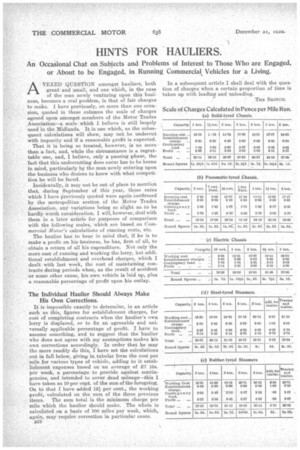HINTS FOR HAULIERS.
Page 26

If you've noticed an error in this article please click here to report it so we can fix it.
An Occasional Chat on Subjects and Problems of Interest to Those Who are Engaged, or About to be Engaged, in Running Commercial Vehicles for a Living.
AVEXED QUESTION amongst hauliers, both great and small, and one which, in the case of the man• newly venturing upon this business, becomes a real problem, is that of fair charges to make. I have previously, on more than one occasion, quoted in these columns the scale of charges agreed upon amongst members of the Motor Trades Association-a. scale which I believe is still largely used in the Midlands. It is one which, as the subsequent calculations will show, may not be undercut with impunity and if a reasonable profit is expected.
That it is being so treated, however, is no more than a fact, and, while the circumstance is a regrettable one, and, I believe, only a passing phase, the fact that this undercutting does occur has to be borne in mind, particularly by the man newly entering upon the business who desires to know with what competition he will be faced.
Incidentally, it may not be out of place to mention that, during September of this year, those rates which I have iireviously quoted were again confirmed by the metropolitan section of the Motor Trades Association, an variations being so slight as to be hardly worth consideration. I will, however, deal with them in a later article for purposes of comparison with the following scales, which are bused on Cammercial Motor's calculations of running costs, etc.
The haulier has to bear in mind that, if he is to make a profit on his business, he has, first of all, to obtain a return of all his expenditure. Not only the mere cost of running and working the lorry, but addi tional establishment and overhead charges, which I dealt with last week, the cost of maintaining contracts during periods when, as the result of accident or some other cause, his own vehicle is laid up, plus a reasonable percentage of profit upon his outlay.
The Individual Haulier Should Always Make His Own Corrections.
It is impossible exactly to determine, in an article such as this, figures for establishment charges, for cost of completing contracts when the haulier's own lorry is displaced, or to fix an agreeable and universally applicable percentage of profit. I have to assume something, and to suggest that the haulier who does not agree with my assumptions makes kis own corrections accordingly. In order that he may the more readily do this, I have set the calculations out in full below, giving in tabular form the cost per mile for various types of vehicle, adding to it establishment expenses based on -an average of 17 10s. per week, a percentage to provide against contingencies, and intended to cover dead mileage-this I have taken as 10 per cent. of the sum of the foregoing. On to that I have added 121 per cent., the working profit, calculated on the sum, of the three previous items. The sum total is the minimum charge per mile 'which the haulier should make. The whole is calculated on a basis of 300 miles per week, which, again, may require correction in particular cases. In a subsequent article I shall deal with the question of charges when a certain proportion of time is taken up with loading and unloading.
THE SICOTCH.
Scale of Charges Calculated in Pence per Mile Run. (a) Solid-tyred Chassis.
































